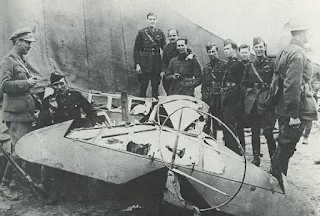 Game Map - That this is one good looking game map that I have seen in a very long time is an understatement. Since the air combat was mostly was over "no man's land", it was a pretty ugly and dismal looking, area. The game map is 64 squares (8 x 8 square grid) and is used to regulate movement. The line pattern you see are trenches (one side or the other, not both as the trenches are all joined).
Game Map - That this is one good looking game map that I have seen in a very long time is an understatement. Since the air combat was mostly was over "no man's land", it was a pretty ugly and dismal looking, area. The game map is 64 squares (8 x 8 square grid) and is used to regulate movement. The line pattern you see are trenches (one side or the other, not both as the trenches are all joined).
With this, I am going to close on this review:
Complexity of the game = LOW.
Solitaire = HIGH (very little work is needed, but very doable!)
Fun Level = HIGH (the only thing missing is the Castor Oil)
Nail biting = 8 fingers worth, lost almost all of those nails.
Length of typical full game = 1 hour to 3 hours (my fault as I took my time!)
Update - 25th April 2019 - Out of the 50+ games, I have played both sides and won and lost, victories have been very even. I tend to think of it as it that as in real life, the game is just the luck of the draw.
Other tidbits of useless info...
Die Dicta Boelcke von Oswald Boelcke
1. Sichere Dir die Vorteile des Luftkampfes (Geschwindigkeit, Höhe, zahlenmäßige Überlegenheit, Position), bevor Du angreifst. Greife immer aus der Sonne an.
2. Wenn Du den Angriff begonnen hast, bringe ihn auch zu Ende.
4. Lasse den Gegner nicht aus den Augen.
5. In jeglicher Form des Angriffs ist eine Annäherung an den Gegner von hinten erforderlich.
6. Wenn Dich der Gegner im Sturzflug angreift, versuche nicht, dem Angriff auszuweichen, sondern wende Dich dem Angreifer zu.
7. Wenn Du Dich über den feindlichen Linien befindest, behalte immer den eigenen Rückzug im Auge.
8. Für Staffeln: Greife prinzipiell nur in Gruppen von 4 bis 6 an. Wenn sich der Kampf in lauter Einzelgefechte versprengt, achte darauf, dass sich nicht viele Kameraden auf einen Gegner stürzen.
Dicta Boelcke by Oswald Boelcke (English)
1. Secure the benefits of aerial combat (speed, altitude, numerical superiority, position) before attacking. Always attack from the sun.
2. If you start the attack, bring it to an end.
3. Fire the machine gun up close and only if you are sure to target your opponent.
4. Do not lose sight of the enemy.
5. In any form of attack, an approach to the opponent from behind is required.
6. If the enemy attacks you in a dive, do not try to dodge the attack, but turn to the attacker.
7. If you are above the enemy lines, always keep your own retreat in mind.
8. For squadrons: In principle attack only in groups of four to six. If the fight breaks up in noisy single battles, make sure that not many comrades pounce on an opponent.
My love of WW1 aviation came about several ways - my family has always been with flying in one form or another. Watching World War I aviation movies (my family has always been involved with movie production and theaters too).
This is my collection of DVDs/Blu-Rays:
The Blue Max (1966) - Good, though one has to think beyond the modern bi-planes used.
Hell’s Angels (1930) - Tops. The action makes up for the love story and even has Zeppelins.
Aces High (1976) - ok, not great.
The Dawn Patrol (1930) - The original. Very good
The Dawn Patrol (1938) - a better remake of the original. Tops
Von Richthofen and Brown (1971) - Good
Wings (1927) - Great movie. Great action and the planes are the real McCoy. Being only 9 years after the great war.
The Eagle and The Hawk (1933) - Good
Suzy (1936) - too much of a love story for my taste.
FlyBoys (2006) - never watched, too much CGI for me
The Great Waldo Pepper (1975) - Interesting story. What starts at the end of WW1 is finished some years later.
Thanks for reading!
-ab out
This content is accurate and true to the best of the author’s knowledge and is not meant to substitute for formal and individualized advice from a qualified professional.
Also I need to add, this blog is considered to be a living blog. Changes will be made to it as needed to clarify, correct errors or update with new information. And I apologize, but this review may contain references to graphics that are no longer on this blog. LOL, it was Google who removed them.







